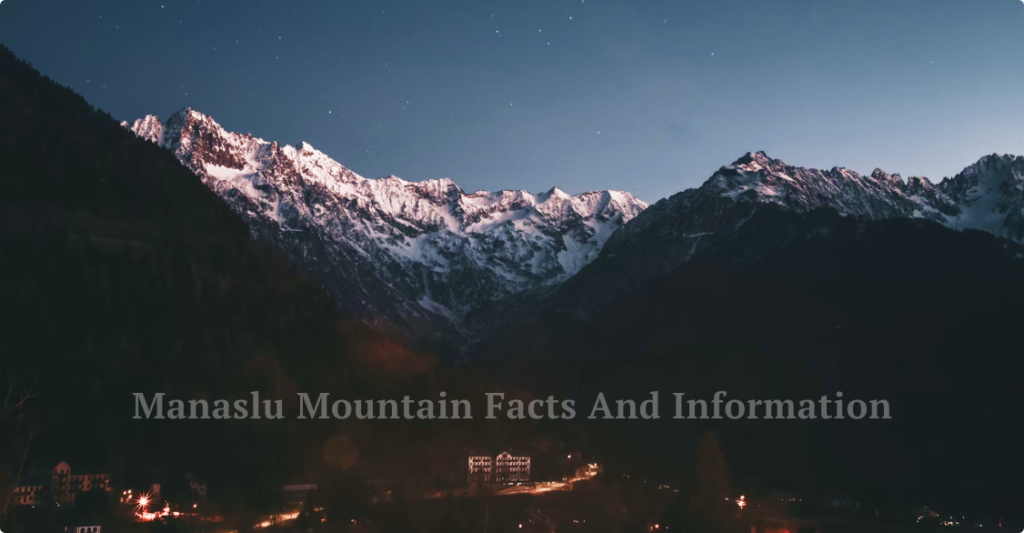Overview
Prior to embarking on the Manaslu trek, trekkers must know about the Manaslu Mountain facts and obtain permission from the Manaslu region. Manaslu, the eighth-highest mountain in the world, stands at 8,163 meters (26,781 ft) and was opened in 1992 A.D. It is situated in the Mansiri Himal, which is part of the Nepalese Himalaya region, in the west-central area of Nepal.
Currently, the Manaslu Trek is regulated by the tourism board and falls under the restricted trekking trail of Nepal. The trek offers breathtaking views of the nearby long ridge mountain range, including Nagdi Himal, Himalchuli, and Boudha Himal. Manaslu, the highest peak in the Gurkha district, provides numerous trekking opportunities in the Annapurna region. The trek follows the ancient salt-trading route along the Budhi Gandaki river. Starting from Arughat, a small town bazaar, the trail concludes in Besisahar.
6 Interesting Manaslu Mountain Facts And Information💡
- Manaslu is located in the Nepalese Himalayas, near the border of Tibet.
- In 1956, a team from Japan successfully climbed Manaslu for the first time.
- Manaslu is considered one of the most challenging mountains to climb due to its steep slopes, difficult climbing routes, and unpredictable weather.
- The mountain gets its name from the Sanskrit word “Manasa,” which translates to “intellect” or “soul.”
- Climbers must obtain permission to climb Manaslu as it is classified as a restricted trekking area by the Nepalese government.
- The Manaslu Conservation Area, situated around the mountain, is home to a variety of plants and animals including snow leopards, musk deer, and Himalayan tahr.
An Exploration of the Eighth Tallest Peak ✨
Location and Height:
Mount Manaslu, located in the Mansiri Himal range of the Gorkha District in Nepal, is the eighth-highest mountain in the world, standing at 26,781 ft (8,163 m) above sea level. Its name, derived from Sanskrit, means ‘mountain of the spirit’. Manaslu is surrounded by four other significant peaks: Himalchuli, Ngadi Chuli, Shringi, and Langpo.
Historical places:
The Gurkha district is home to Mount Manaslu, which boasts numerous historical sites such as the Manakamana Temple and Gurkha Durbar. This trek offers both beauty and adventure, with breathtaking views of Manaslu and a journey through various Hindu and Tibetan villages. Additionally, trekkers will pass through lush green forests, witness ancient architecture, and encounter Buddhist Monasteries where young children study to become monks.
Ethnicity and religion:
Manaslu has a lot in common with Tibet in terms of culture and history. The region is mainly inhabited by two ethnicities: Tsum and Nubri. The Gurung ethnic group has a significant presence in the Brigade of Gurkhas. The Bhutias and Sherpa groups, who are similar to the Tibetans, are also found in this area. The local people have a rich tradition and culture, living in unique houses made of stone walls and slabs for roofs.
Many houses were destroyed by the earthquake and are still being rebuilt. The main occupations of the locals are agriculture and animal husbandry, including crops like barley and maize, and fruits like oats and nuts. In addition, they earn income from lodges and small tea houses. The local people mostly come from Tibet and speak their own languages.
Climbing History and Challenges:
Manaslu is still considered one of the most difficult climbs in the Himalayas because of its steep slopes, dangerous paths, and unpredictable weather. The mountain was first successfully climbed on May 9, 1956 by Japanese climbers Toshio Imanishi and Gyalzen Norbu. Currently, climbers are still required to obtain special permits from a licensed trekking agency in order to attempt the ascent.
Conserved Wildlife:
The Manaslu region is home to a diverse range of wildlife, including musk deer, Himalayan tahr, red pandas, and over 200 species of birds. Conservation efforts have played a crucial role in preserving the natural habitat of these animals. Since the 1950s, hunting has been prohibited in the area, initially due to the sacred beliefs of the local Gurung people. The Manaslu Conservation Area Project is actively involved in safeguarding the region’s ecosystem, combating poaching, and promoting sustainable tourism. Additionally, a portion of the fees collected from trekking permits is allocated towards conservation and community development initiatives.
Wildlife and Culture:
The region around Manaslu has seen wildlife conservation due to a hunting ban implemented by local monasteries. Trekkers have the opportunity to observe species such as the Himalayan tahr, musk deer, and Himalayan goral. Additionally, the trail passes through several villages that have adopted community-based tourism, providing visitors with a chance to immerse themselves in the local Buddhist culture.
Tsum Valley and Nubri Valley ✨
The Manaslu region of Nepal is home to two main inhabited valleys: Tsum Valley and Nubri Valley. Tsum Valley is a remote area with a rich history of Buddhism. It is also known as ‘Tsum Tso Chuksum’, meaning thirteen provinces ruled as a single territory. The ancient Tsum Kingdom still exists, and the village has a unique traditional culture. Trekking in Tsum Valley offers stunning views of the Ganesh massif, with four peaks reaching 7,000 meters. Visitors can also immerse themselves in the distinct Tibetan culture of the Tsumba people.
Nubri Valley is another remote area in the region, known for its untouched natural beauty. The local people here maintain their traditions, culture, and art. They wear traditional clothing and speak their own language. The ancient trail in this area showcases a mix of cultures, particularly Tibetan, and offers great hospitality. There are small tea houses and lodges available for accommodation, and an ancient Buddhist monastery that provides a glimpse into Buddhist culture.
Larkya La Pass ✨
Larkya La pass, also called Larke Pass, is situated at an impressive altitude of 5,106 meters. From here, trekkers can enjoy breathtaking views of Mount Manaslu, Ganesh Himal, and various other mountain ranges. Despite being at a lower elevation compared to passes like Thorong La Pass and Chola Pass, Larke Pass is considered more challenging due to its lengthy trek and higher altitude. Moreover, the descent from Bhimtang is more technical and requires climbing skills.
Additional Peaks and Trekking ✨
Manaslu is surrounded by four major peaks: Himalchuli (25,896 ft), Ngadi Chuli (25,823 ft), Shringi (23,579 ft), and Langpo (21,877 ft). The region is well-known for trekking, particularly the Manaslu Circuit Trek, which offers breathtaking views of the mountain. This trek usually takes 15 to 20 days and includes crossing several high mountain passes. Manaslu is a place that remains mysterious and spiritual. Its treacherous yet captivating slopes continue to attract experienced climbers, while its unique culture and natural beauty entice trekkers from all over the globe. For those seeking adventure in the Himalayas, there is nothing quite like Manaslu
Climbing Routes✨
The Northeast Ridge is the most popular route to climb Manaslu. It goes up to the North-Northeast Face and includes unstable slopes with narrow ridges of up to 50 degrees. The route also involves sections of rock climbing and icy traverses, making it challenging. The South Face and West Face routes have treacherous terrain and snowfields prone to avalanches, so they are only recommended for highly skilled mountaineers. Due to the risks involved, only experienced climbers who are familiar with technical high-altitude routes should try to summit Manaslu.
Unpredictable Weather✨
The Nepalese Himalayas’ remote location of Manaslu exposes climbers to severe and rapidly changing weather conditions. Temperatures frequently drop well below freezing, the upper slopes are often battered by strong winds, and camps and routes can be buried under heavy snowfall. These challenging conditions can last for days, leaving climbers stranded at high altitudes and depleting their resources. Additionally, sudden storms can trigger avalanches, posing a threat to climbers and porters on the route.
To ensure safety and success, careful planning is required when climbing Manaslu. Climbers must have a comprehensive understanding of the mountain’s terrain and typical weather patterns in order to adequately prepare for any difficulties that may arise during their ascent. By thoroughly preparing and exercising caution, climbers can reduce the risks associated with the challenging climbing routes and climate of this formidable peak. However, due to the unpredictable weather, there is always a certain level of danger when attempting to conquer this Himalayan giant.
Conclusion 😊
Manaslu mountain facts and information helps trekkers and climbers in many ways to conquer Mount Manaslu. Manaslu region in Nepal is a difficult but rewarding climb for experienced mountaineers looking to reach one of the highest peaks in the world. The steep slopes, unpredictable weather, and remote location in the Himalayas make Manaslu a true test of human endurance.
However, the mountain also provides breathtaking views and a unique cultural experience for those brave enough to explore its lofty heights. Whether you aspire to reach the peak or just hike around the base, Mount Manaslu calls out to the adventurous spirit within each of us. As you get ready for your own escapades, always keep the breathtaking views and tough obstacles of this majestic mountain in mind. With careful preparation and unwavering perseverance, you too can someday conquer the renowned Mount Manaslu.
Frequently Asked Questions
Manaslu, also known as Kutang, is the eighth-highest mountain in the world at 8,163 metres (26,781 ft) above sea level. It is located in the Mansiri Himal, which is part of the Nepalese Himalayas, in west-central Nepal.
Manaslu, also known as Kutang, is the eighth-highest mountain in the world at 8,163 metres (26,781 ft) above sea level. It is located in the Mansiri Himal, which is part of the Nepalese Himalayas, in west-central Nepal.
Manaslu, also known as Kutang, is the eighth-highest mountain in the world at 8,163 metres (26,781 ft) above sea level. It is located in the Mansiri Himal, which is part of the Nepalese Himalayas, in west-central Nepal.
Manaslu, also known as Kutang, is the eighth-highest mountain in the world at 8,163 metres (26,781 ft) above sea level. It is located in the Mansiri Himal, which is part of the Nepalese Himalayas, in west-central Nepal.
Manaslu, also known as Kutang, is the eighth-highest mountain in the world at 8,163 metres (26,781 ft) above sea level. It is located in the Mansiri Himal, which is part of the Nepalese Himalayas, in west-central Nepal.

